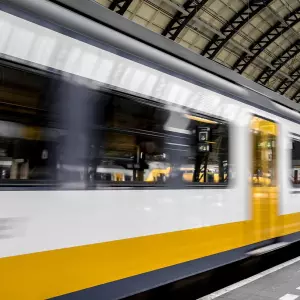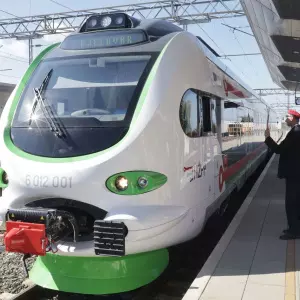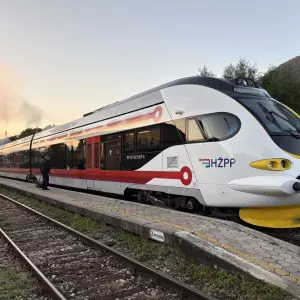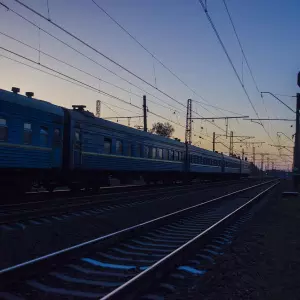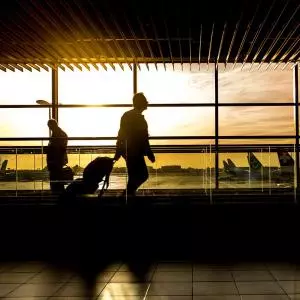Danas je potpisan je Ugovor o kupoprodaji 6 elektrodizelskih motornih vlakova za povezivanje Splita i Zagreba.
Vrijednost projekta, koji se financira iz zajma Europske investicijske banke (EIB), iznosi 57,3 milijuna eura. Zajam s EIB-om za projekt Revitalizacija željezničkog sustava RH sklopljen je u veljači 2024., a u sklopu njega financirat će se nabava vlakova, izgradnja Tehničko-logističkog centra Zagreb te obnova i izgradnja lokalnih i regionalnih pruga te kolodvora i stajališta.
Ugovor su potpisali predsjednik Uprave HŽ Putničkog prijevoza Željko Ukić i predsjednik Uprave KONČAR - Električnih vozila Josip Ninić.
Potpisivanju ugovora bili su nazočni predsjednik Vlade RH Andrej Plenković, potpredsjednik Vlade i ministar mora, prometa i infrastrukture Oleg Butković, potpredsjednik Vlade i ministar prostornoga uređenja, graditeljstva i državne imovine Branko Bačić, ministar turizma i sporta Tonči Glavina, splitsko-dalmatinski župan Blaženko Boban i predsjednik Uprave KONČAR - Elektroindustrije Gordan Kolak.
Ono što je najvažnije građanima, je kako će vlakovi omogućiti bolju povezanost Splita i Zagreba te više dnevnih polazaka, čime će biti osigurana kvalitetnija lokalna i regionalna povezanost te mobilnost građana
"Novi vlakovi zamijenit će nagibne vlakove koji voze između Splita i Zagreba od 2004. godine. Za dvije godine na pruzi će biti prvi vlak, potom će u promet biti pušten po jedan vlak mjesečno te ćemo do kraja 2026. imati potpuno obnovljen vozni park između ova dva grada. Nabava ovih 6 vlakova omogućit će više dnevnih polazaka između Splita i Zagreba. Upravo kvalitetno željezničko povezivanje predstavlja veliki potencijal u cilju povećanja broja putnika. I to baš ekološki najprihvatljivijim, energetski najučinkovitijim i cjenovno prihvatljivim načinom prijevoza. Novi će vlakovi omogućiti bolju povezanost i izuzetno nas veseli da ćemo kvalitetu usluge podići na jednu novu razinu.", istaknuo je predsjednik Uprave HŽ Putničkog prijevoza Željko Ukić.
Zagreb i Split povezuje pruga duljine 429 km koja je elektrificirana od Zagreba do Oštarija, a od Oštarija do Splita neelektrificirana, tijekom vožnje koristit će se električni i dizelski pogon, uz veliku snagu vučnih motora kako bi se udovoljilo uvjetima zahtjevne brdske pruge.
"Vlakovi će postizati maksimalnu brzinu od 160 km/h, a bit će omogućeno i funkcionalno spajanje više vlakova, čime će biti osiguran veći kapacitet. Isporukom novih vozila KONČAR nastavlja trend razvoja proizvoda i rješenja kojima se smanjuje štetan utjecaj na klimu, nudi dugogodišnja održivost proizvoda te digitalizacija okrenuta budućnosti. Neprekidnim unaprjeđenjem tehnologija u području mobilnosti doprinosimo jednom od najvažnijih ciljeva Europske unije - uspostavi zelenog i održivog prometa. Naši vlakovi pripadaju u sam vrh visokotehnoloških proizvoda hrvatske industrije, a ono što posebno treba istaknuti jest da u njihovoj realizaciji sudjeluje i cijeli niz hrvatskih poduzeća pa tako i onih s područja Dalmacije. U nadolazećem razdoblju kao zemlja moramo nastaviti osiguravati uvjete u kojima će biti lakše i poželjnije ulagati u razvoj i u kojima će nacionalno gospodarstvo moći osigurati potrebne reference kao preduvjet za snažniji izlazak izvan granica Hrvatske.", istaknuo je predsjednik Uprave KONČAR - Elektroindustrije Gordan Kolak.
Potpredsjednik Vlade i ministar Oleg Butković istaknuo je kako su uz nabavu novih vlakova u tijeku i velika ulaganja u modernizaciju željezničke infrastrukture. Iz EU fondova financiraju se projekti obnove i izgradnje pruga na glavnim koridorskim prugama, a zajmom Europske investicijske banke obnavljaju se lokalne i regionalne pruge.
"Danas u prometu imamo 61 novi vlak, a samo u proteklih nekoliko godina nabavljena su i u promet puštena 33 nova vlaka. Do kraja sljedeće godine imat ćemo ukupno 70 novih vlakova, odnosno više od polovice cijele flote. Također, budući da je došlo do važne izmjene na prometnoj karti, što osobito vrijedi za područje Dalmacije, koje je po prvi puta uvršteno na mrežu europskih prometnih koridora, otvaraju nam se mogućnosti sufinanciranja modernizacije i ličke pruge iz EU fondova. Već sada se radi na postavljanju signalno-sigurnosnih uređaja i daljinskog upravljanja na dionici od Oštarija do Knina, a iz NPOO-a će se osigurati i sredstva za nastavak ugradnje od Knina prema Splitu, što će omogućiti i brža putovanja na ovoj pruzi.", rekao je potpredsjednik vlade i ministar mora prometa i infrastrukture Oleg Butković.
S obzirom da je Split drugi najveći grad u RH i važno turističko čvorište preko kojega su povezana mnoga mjesta na obali i otocima, kvalitetno željezničko povezivanje Splita i Zagreba predstavlja veliki iskorak u cilju povećanja broja prevezenih putnika.
Tehničke karakteristike novih vlakova
Elektrodizelski motorni vlakovi bit će niskopodne kompozicije, imat će troja vrata sa svake strane vlaka, bit će opremljeni rampama za ulazak i izlazak osoba u invalidskim kolicima, prostorom za bicikle i toaletima, od kojih će jedan biti prilagođen ulasku osoba u invalidskim kolicima. Kompletan putnički prostor bit će pod videonadzorom. U prostoru za putnike bit će postavljeni monitori za prikaz videosadržaja. Uz vizualne i audionajave kolodvora i stajališta, putnicima u vlaku bit će omogućen besplatan pristup internetu (WiFi).
Vlakovi će biti opremljeni suvremenim informacijskim sustavom za obavještavanje putnika, utičnicama i samoposlužnim aparatima za hranu i piće. Kapacitet vlaka biti će 150 sjedećih mjesta (12 u 1. razredu, 138 u 2. razredu).
"Ovaj današnji ugovor između HŽPP-a i Končara me zaista veseli jer to je okretanje nove stranice što se tiče željeznice i željezničkog prijevoza na relaciji Zagreb - Split sa 6 novih vlakova. S tim da sada uistinu treba prionuti, kako je rekao i sam ministar, obnovi infrastrukture kako bi ti vlakovi vozili po adekvatnim tračnicama od Zagreba do Splita. Nadamo se da ćemo sve to do 2027. staviti u funkciju.", istaknuo je splitsko - dalmatinski župan Blaženko Boban.
I tu dolazimo do glavnog pitanja koje zanima putnike. Osim modernizacije vlaka, kako po udobnosti tako i dostupnosti WiFi-a i utičnicom za struju, ključno pitanje je koliko će trajati putovanje između Zagreba i Splita tj. hoće li se vrijeme putovanja smanjiti?
Vlakovi će moći postizati maksimalnu brzinu od 160 km/h, no pitanje hoće li smanjiti vrijeme putovanja, jer problem je stara infrastruktura tračnica, koja je ograničavajući faktor. Trenutno najbrže prema HŽ-ovom voznom redu iz Zagreba do Splita ( duljine 429 km ) vlakom možete doći 06 sati i 35 minuta, ukoliko nema kašnjenja.
Kako je i ministar mora prometa i infrastrukture istaknuo, spomenuta trasa je uvrštena na mrežu europskih prometnih koridora što daje mogućnost korištenja EU fondova za obnovu pruge, što je svakako dobra vijest, no što također znači kako ćemo se za radikalno smanjenje trajanje puta vlakom iz Zagreba u Split i obrnuto morati još načekati.
Pozitivno je što su napravili pretpostavke za danji razvoj tj. jačanje željezničke infrastrukture, postoje planovi i opcije financiranja te u konačnici što su se stvari pokrenule s "mrtve točke". To je prvi korak.
Naslovna fotografija: HŽPP / Google maps / Ilustracija: hrturizam

